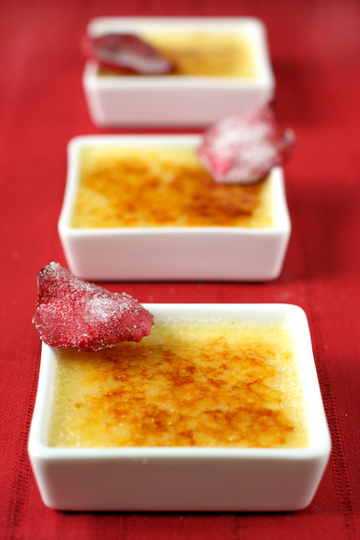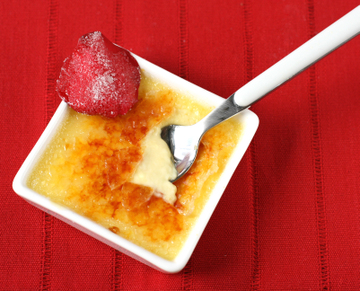Rosebud Crème Brûlée
I’m late to the SHF party! But when I saw the flower theme I couldn’t resist putting something together, even at the last minute.
This is a rendition of one of Citizen Cake’s signature desserts. Billed as the "pastry chef’s restaurant", Citizen Cake has reigned in San Francisco for years as both an elegant full-service restaurant and a top-notch pâtisserie. Cakes, pastries, confections, and ice creams come out of Elizabeth Falkner’s kitchen in a dizzying swirl, all classically based but with modern, playful twists: the popular Retro Tropical Shag is composed of layers of rum-soaked genoise filled with passionfruit mousse and vanilla buttercream and covered with coconut so it does, indeed, resemble those funky shag carpets. The charming Mocha Mi Su puts a spin on traditional tiramisu by mixing cocoa genoise with mocha mousse, chocolate ganache, and coffee buttercream.
Falkner’s composed desserts really highlight her penchant for wordplay and kitchen-play – sophisticated combinations of flavors and textures, with a clever little in-jokes for names. For example, one of the their current desserts is named "Wagashi 2010", wagashi being traditional Japanese confections such as mochi, but Citizen Cake’s rendition includes a dried persimmon mochi cake, crispy green tea soba, milk gelato, and a nori croquant. One of my favorite desserts the last time I went was the "Cha Cha Cha", composed of a tropical tamale with passionfruit crème brûlée and mojito paleta.
Falkner’s rose petal crème brûlée is a staple on the menu; served with saffron-pistachio cookies, it’s a delicate, floral air-kiss of dessert. Crème brûlée, like chocolate mousse, is another one of those desserts that can seem tired or overdone on menus, but done well in the hands of an expert, you remember exactly why it’s so beloved.
As with all baked custards, the proof is in the baking – how you cook and supervise the custards will determine whether it achieves that delicate unctuous texture or it becomes tough and eggy. Custards need to bake evenly and slowly at a low temperature. This is why water baths are used – to help provide a gentle moist environment for the eggs in the custard to cook. I also place a towel on the bottom of the baking pan between the ramekins to further prevent any direct heat on the ramekins. Finally, if you want even more protection, you can always place a piece of aluminum foil over the top of the baking with some vent holes pierced in.
When the cooking time for the custards is done, check to see if the tops of the custards are set – they should shimmy slightly but the center should not move separately from the rest of the custard. You can also stick a thin knife into the custard (not in the center) and see if it comes out clean.
If they don’t appear done, close the oven and bake for another 6-7 minutes. Resist the urge to constantly check on the custards; every time you open the oven more heat escapes, so given the low baking temperature you could end up with the custards never baking.
Of course, the best part of crème brûlées is the caramelizing of the sugar. I never thought I harbored any latent pyromania but there is a definite thrill in wielding a blowtorch and watching sugar bubble and brown beneath your eyes, forming that perfect crystalline surface just waiting for that Amélie-like tap-tap-tap.
Crème brûlées take very well to infusions of flavor, from teas to fruits to spices. I particularly enjoy this rose-scented one: sweet and springlike, the custard melts like silk on the tongue, leaving a whisper of rose and orange. The crystallized rose petals add a pretty dash of color; it is spring, after all, and the flowers are definitely in bloom!
Rosebud Crème Brûlée
makes about 6 servings in 4 1/2 ounce ramekins
2 cups heavy cream
1/8 teaspoon vanilla seeds, or 1/2 teaspoon vanilla extract
3 ounces egg yolks (about 4-5 eggs)
2 ounces sugar
1/4 teaspoon Grand Marnier
1/2 teaspoon rose water
Preheat the oven to 300 degrees F.
Find a baking pan that will fit all of the ramekins you plan to use. The sides of the pan should be at least as high as the ramekins. Line the bottom of the baking pan with a towel.
Heat the cream and vanilla in a medium saucepan on medium heat until it comes to a boil. Remove from heat and let sit for about 10 minutes for the vanilla to infuse.
Whisk the eggs and sugar together in a bowl.
Slowly pour about a third of the hot cream into the eggs, whisking all the time to prevent the eggs from curdling.
Pour the tempered eggs back into the cream, whisking constantly until combined. Whisk gently to prevent bubbles from forming.
Strain the mixture into a clean bowl.
Add the Grand Marnier and rose water and let the custard cool slightly.
Arrange the ramekins in the baking pan on top of the towel. Using a ladle, carefully, pour the custard into the ramekins, filling just below the rim. Try to fill all of the ramekins to the same height so they will bake evenly.
Carefully pour hot water into the baking pan until it comes up about 2/3 of the way up the sides of the ramekins. Do not let the water get into the pan.
Carefully place the baking pan into the oven and bake for about 45 minutes to an hour until set. I checked at about half an hour and at 45 minutes, but don’t open the oven door too often or you’ll lose all the heat and the custards will not cook. You can check the progress of the custards by sticking a paring knife into the custard slightly away from the center. If it comes out covered in liquidy custard, it’s not done yet. Also, if you lightly touch the center of the custard and your fingertip comes away covered in custard it is also not done.
When the custards are done, they should shimmy slightly when you move the pan (careful not to spill water!) but the center should not move separately. If, however, it has set like Jello and there are bubbles forming on the top it is becoming overcooked and you should remove the custards immediately. If the custards start rising at any point they have become overcooked.
After you remove the baking pan from the oven and the ramekins have cooled enough to handle, remove the ramekins, cover them, and chill in the refrigerator for at least 4 hours before serving.
When you are ready to serve the crème brûlées, take one ramekin at a time and sprinkle the top with sugar evenly over the top. Using a hand-held blowtorch, carefully caramelize the sugar. Keep the flame at least 2 inches from the sugar to prevent burning the sugar. You can also caramelize the sugar under a broiler.
Let the sugar cool for a couple of minutes before serving. Do not brûlée the custards more than 20 minutes before serving or the sugar may melt.



No comments:
Post a Comment